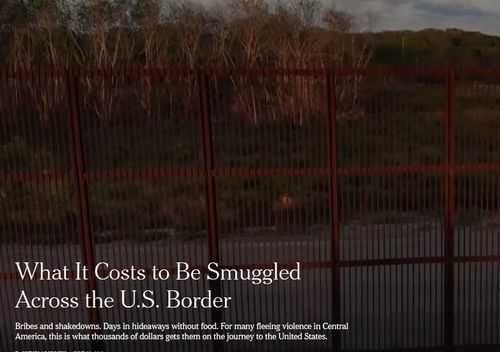


07/01/2018
Sunday’s New York Times featured an illegal alien sob story, emphasizing the cost and danger of reaching the US.
Readers learn that the Times’ hero of the story, Salvadoran Christopher Cruz, apparently spent $12,500 to reach America’s welfare offices, though the exact sum is not clear. That’s a great deal of money for a poor unskilled Central American which he obviously believes he can somehow mooch back in the wealthy United States.
Additionally interesting were facts about the big picture of people smuggling, in particular that “migrants paid $500 million a year to groups fueling violence and instability in the region.” That’s a lot of money going to cartels — no wonder they are so powerful.
Imagine if all that money and human energy were repurposed to reform in the home countries. There used to be revolutions in Latin America, but now it’s just easier for young men, like the 22-year-old subject of the Times article, to break into the United States to steal jobs and benefits from citizen taxpayers. Illegal immigration is theft.
True, Central America is a third-world hellhole, but all its millions of unhappy people cannot come here and spread the poison of lawlessness in this country.
To be fair, the United States has been unduly generous to foreign lawbreakers who can manage to stay legally or illegally, a policy that constituted a human magnet.
Below, President Obama’s deluxe Karnes Detention Center for illegal aliens included flat-screen TVs, a hair salon and brand new clothes — at a cost to taxpayers of $140 per day per foreigner.

So President Trump is correct to apply severe negative reinforcement to counteract years of Obama’s pampering of lawbreakers. But the Republican-run Congress is not serious about immigration enforcement, otherwise it would have enacted universal E-Verify.
Back to The New York Times article — note the communist-style entitlement felt by the Salvadoran who says, “They can send as many soldiers to the border as they want, but a people’s need and desire for a better life is stronger.”
What It Costs to Be Smuggled Across the U.S. Border, June 30, 2018
MATAMOROS, Mexico — Shortly before dawn one Sunday last August, a driver in an S.U.V. picked up Christopher Cruz at a stash house in this border city near the Gulf of Mexico. The 22-year-old from El Salvador was glad to leave the one-story building, where smugglers kept bundles of cocaine and marijuana alongside their human cargo, but he was anxious about what lay ahead.
The driver deposited Mr. Cruz at an illegal crossing point on the edge of the Rio Grande. A smuggler took a smartphone photograph to confirm his identity and sent it using WhatsApp to a driver waiting to pick him up on the other side of the frontier when — if — he made it across.
The nearly 2,000-mile trip had already cost Mr. Cruz’s family more than $6,000 and brought him within sight of Brownsville, Tex. The remaining 500 miles to Houston — terrain prowled by the United States Border Patrol as well as the state and local police — would set them back another $6,500.
It was an almost inconceivable amount of money for someone who earned just a few dollars a day picking coffee beans back home. But he wasn’t weighing the benefits of a higher-paying job. He was fleeing violence and what he said was near-certain death at the hands of local gangs.
“There’s no other option,” Mr. Cruz said. “The first thought I had was, ‘I just need to get out of here at whatever cost.’”
The stretch of southwest border where he intended to cross has become the epicenter of the raging battle over the Trump administration’s immigration crackdown. One clear consequence of the tightening American border and the growing perils getting there is that more and more desperate families are turning to increasingly sophisticated smuggling operations to get relatives into the United States.
Mr. Cruz’s story provides an unusually detailed anatomy of the price of the journey. The money paid for a network of drivers who concealed him in tractor-trailers and minibuses, a series of houses where he hid out, handlers tied to criminal organizations who arranged his passage, and bribes for Mexican police officers to look the other way as he passed.
Even with his family’s payment, he slept amid filth and vermin. He watched guides abandon some migrants who could not keep up, and guards prod others to become drug mules. Sometimes the smugglers identified him by a numeric code, other times by an assumed name. But as often as not, they simply called him “the package,” to be moved for profit like an illicit good.
For Mr. Cruz, it was worth it. “They can build as many walls as they want,” he said, referring to American officials. “They can send as many soldiers to the border as they want, but a people’s need and desire for a better life is stronger.”
President Trump and his supporters have called for greater vigilance along the border to keep out people like Mr. Cruz, a low-skilled worker who followed in the path of other family members who also arrived illegally, and who hopes those left behind will join him.
Pledging to halt illegal immigration, Mr. Trump has pushed for a 1,000-mile wall, ordered National Guard units to the border and encouraged workplace roundups of undocumented immigrants, which had largely been curtailed during the Obama years.
But as the number of Central Americans arriving at the southern border or sneaking across it has surged in recent months, the administration has embraced even tougher measures: “zero tolerance” for those arriving illegally, by requiring criminal prosecutions; family separation, a policy from which Mr. Trump was forced to retreat after images of children wailing for their parents provoked a public outcry; and eliminating domestic violence and gang violence as grounds for granting asylum to migrants who arrived at legal crossing points.